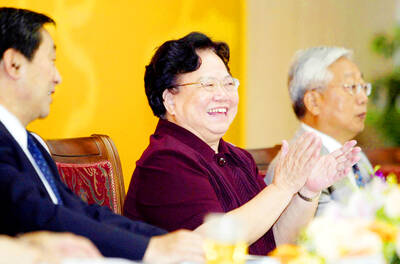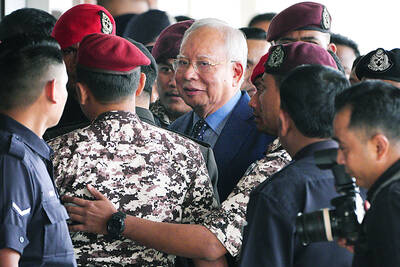In Mexico, the world's second-biggest Catholic country, an unofficial cult of death is winning followers, from influential politicians and police officers to drug pushers and violent criminals.
On a sidewalk in Mexico City's lawless Tepito district, gangsters and ordinary housewives rub shoulders as they pay homage before a shrine to Santa Muerte, or Saint Death, leaving offerings of colored candles, cigarettes and alcohol.
A statue of the unorthodox saint cuts a ghoulish figure as a life-size skeleton in a glittering robe, a tiara atop her long-haired wig and bony fingers laden with gold rings and money offerings in many currencies.

PHOTO: REUTERS
"I ask her to look after me in my businesses and to rid me of my envious thoughts," said Roberto Gutierrez, a tough-looking street hawker in sunshades. Gutierrez stops by the shrine every day and carries a prayer to Santa Muerte in his wallet.
Like many Santa Muerte wor-shippers, Gutierrez asks God's permission to pray to Death, unconcerned by the contradiction between practicing Christianity and a growing pagan cult, which is experiencing a revival after lying dormant until the 1960s.
"First for me comes God and then Santa Muerte," he said.
Before her glass casing, followers deposit apples and eggplants to symbolize abundance, flowers, glasses of tequila and half-smoked cigarettes. Some blow cigar smoke over her image in a cleansing rite.
"She likes it when we do that. She likes the smell of tobacco," said Enriqueta Romero, who tends the shrine.
A funeral cortege of gangsters sporting shades and gold chains passed by in gleaming cars, music blaring, saluting the shrine as they went.
"People ask her: `Protect me tonight because I am going to kidnap or assault somebody,'" said Mexican writer and poet Homero Aridjis, who documented this thriving cult in a book of fictional stories called "Santa Muerte."
The title story is based on a debauched birthday party Aridjis attended of a powerful politician with links to drug traffickers.
At the host's lavish ranch, where former beauty queens plied guests with alcohol and cocaine, Aridjis says he witnessed members of Mexico's political and business elite worship at a secret altar to Santa Muerte -- his first encounter with the phenomenon.
PAGAN DEVOTION
Mexicans have long had a complex relationship with death. Ancient indigenous cultures worshipped a god of death called Mictlantecuhtli, and the Aztecs believed mass human sacrifice was vital to feed the gods and keep the life cycle going.
Even after the Spanish conquest brought Catholicism to the region, Mexicans retained a strong pagan devotion to death, as seen by their celebration every November of the Day of the Dead when they erect altars to the dead in their homes and prepare elaborate meals for the departed souls. It is akin to Roman Catholics' observation on Nov. 2 of All Souls' Day, when they pray for the souls of the faithful departed.
"The cult to Santa Muerte is a syncretism between the Catholic Church and pre-Colombian worship of death," Aridjis said.
Halloween, originally a Celtic pagan feast of the dead to mark the end of the harvest and start of winter, is celebrated in the US and parts of Europe, mainly as a commercial holiday.
The cult of Santa Muerte has seen a revival in the past decade, a revival which Aridjis attributes to disillusionment with "the system."
"There is a complete disappointment with the government, people can't expect anything from the politicians, the parties or the established Church," he said.
A shrine to the Virgin of Guadalupe, Mexico's beloved dark-skinned version of Mary, stands on the next street corner from the macabre Tepito shrine.
"Santa Muerte is a saint like any other. She performs many miracles," said shaven-headed taxi driver Eduardo Ruben Villegas, 35, who sports multiple tattoos and has an altar in his home to Santa Muerte.
He has been a devotee since she cured his sister of cancer, he said.
Villegas has an image of Santa Muerte hanging from the rear view mirror of his taxi, on his car keys and on three pendants he wears around his neck.
"She protects me a lot in my car. I haven't ever been assaulted," he said.
PAYING RESPECTS
On the first day of every month, hundreds of devotees line up around the block to pay their respects to the skeletal saint, who with her scythe resembles the Grim Reaper.
Romero changes Santa Muerte's dress before each monthly ceremony, at which mariachis serenade her in a celebration of death and life.
The offerings multiply and followers light different colored candles -- red for love, white for protection and black to do harm to an enemy.
Romero also leaves out food daily for the grinning figurine -- tamales, or corn dumplings, "for breakfast" and quesadillas and other treats later in the day.
Police presence is rare in Tepito, where drugs, firearms and smuggled goods are peddled freely.
But there is an unspoken rule that at Santa Muerte's shrine, worshippers pray in safety by day and by night and Romero asks no questions of them.

The death of a former head of China’s one-child policy has been met not by tributes, but by castigation of the abandoned policy on social media this week. State media praised Peng Peiyun (彭珮雲), former head of China’s National Family Planning Commission from 1988 to 1998, as “an outstanding leader” in her work related to women and children. The reaction on Chinese social media to Peng’s death in Beijing on Sunday, just shy of her 96th birthday, was less positive. “Those children who were lost, naked, are waiting for you over there” in the afterlife, one person posted on China’s Sina Weibo platform. China’s

‘NO COUNTRY BUMPKIN’: The judge rejected arguments that former prime minister Najib Razak was an unwitting victim, saying Najib took steps to protect his position Imprisoned former Malaysian prime minister Najib Razak was yesterday convicted, following a corruption trial tied to multibillion-dollar looting of the 1Malaysia Development Berhad (1MDB) state investment fund. The nation’s high court found Najib, 72, guilty on four counts of abuse of power and 21 charges of money laundering related to more than US$700 million channeled into his personal bank accounts from the 1MDB fund. Najib denied any wrongdoing, and maintained the funds were a political donation from Saudi Arabia and that he had been misled by rogue financiers led by businessman Low Taek Jho. Low, thought to be the scandal’s mastermind, remains

‘POLITICAL LOYALTY’: The move breaks with decades of precedent among US administrations, which have tended to leave career ambassadors in their posts US President Donald Trump’s administration has ordered dozens of US ambassadors to step down, people familiar with the matter said, a precedent-breaking recall that would leave embassies abroad without US Senate-confirmed leadership. The envoys, career diplomats who were almost all named to their jobs under former US president Joe Biden, were told over the phone in the past few days they needed to depart in the next few weeks, the people said. They would not be fired, but finding new roles would be a challenge given that many are far along in their careers and opportunities for senior diplomats can

Australian Prime Minister Anthony Albanese yesterday announced plans for a national bravery award to recognize civilians and first responders who confronted “the worst of evil” during an anti-Semitic terror attack that left 15 dead and has cast a heavy shadow over the nation’s holiday season. Albanese said he plans to establish a special honors system for those who placed themselves in harm’s way to help during the attack on a beachside Hanukkah celebration, like Ahmed al-Ahmed, a Syrian-Australian Muslim who disarmed one of the assailants before being wounded himself. Sajid Akram, who was killed by police during the Dec. 14 attack, and